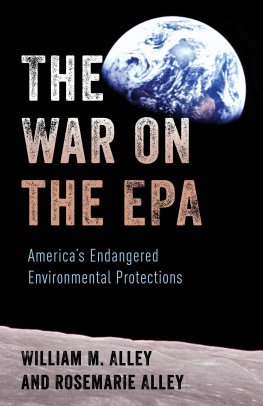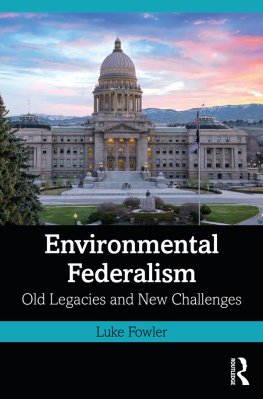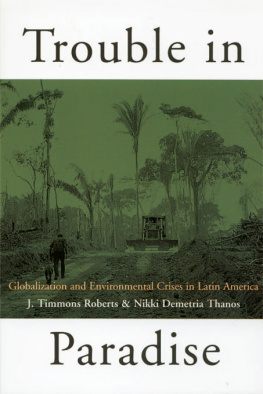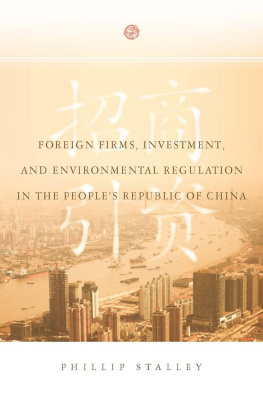The War on the EPA
The War on the EPA
Americas Endangered
Environmental Protections
William M. Alley
and
Rosemarie Alley
ROWMAN & LITTLEFIELD
Lanham Boulder New York London
Published by Rowman & Littlefield
An imprint of The Rowman & Littlefield Publishing Group, Inc.
4501 Forbes Boulevard, Suite 200, Lanham, Maryland 20706
www.rowman.com
6 Tinworth Street, London SE11 5AL
Copyright 2020 by The Rowman & Littlefield Publishing Group, Inc.
All rights reserved. No part of this book may be reproduced in any form or by any electronic or mechanical means, including information storage and retrieval systems, without written permission from the publisher, except by a reviewer who may quote passages in a review.
British Library Cataloguing in Publication Information Available
Library of Congress Cataloging-in-Publication Data
Library of Congress Control Number: 2019953375
ISBN: 978-1-5381-3150-3 (cloth : alk. paper)
ISBN: 978-1-5381-3151-0 (electronic)
 TM The paper used in this publication meets the minimum requirements of American National Standard for Information SciencesPermanence of Paper for Printed Library Materials, ANSI/NISO Z39.48-1992.
TM The paper used in this publication meets the minimum requirements of American National Standard for Information SciencesPermanence of Paper for Printed Library Materials, ANSI/NISO Z39.48-1992.
This book is dedicated to the many current and past U.S. Environmental Protection Agency employees who are committed to protecting our environment.
About the cover: Earthrise is a photograph of the Earth and some of the Moons surface that was taken on Christmas Eve, 1968, during the Apollo 8 mission, the first manned voyage to orbit the Moon. No one had ever seen an earthrise, and the emotional effect was a complete surprise to the Apollo 8 astronauts. Depicting the Earth as isolated and small against the vast blackness of space, it is one of the most iconic images of all time and inspirational for the environmental movement of the 1970s.
Acknowledgments
This book would never have been written without the help and insights of those who care about the U.S. Environmental Protection Agency and its role in peoples lives. Suzanne Staszak-Silva at Rowman & Littlefield cheerfully guided us through each step in the publication process. Stacy Eisenstark, Lynn Goldman, Dave Jones, Alan Kolok, Jeff Kuhn, Paul Martin, John Mundell, Jovita Pajarito, Martin Lowenfish, Haley Waldkoetter, Barbara Wilson, John Wilson, and Mike Wireman all generously gave of their time for discussions and other input. The perspectives on the Environmental Protection Agency and any errors are ours alone. Finally, were grateful to the Harvard Environmental and Energy Law Program for its Regulatory Rollback Tracker website, which documents the environmental regulatory rollbacks of the Trump administration. Circle of Blue and Aquafornia also provided useful daily coverage of important environmental news stories.
Introduction
Over the past couple of decades, Americans have been subjected to a systematic propaganda campaign to discredit science. Championed by ultra-conservatives, this campaign has come alarmingly close to accomplishing its goal by elevating people who dont have a clue what theyre talking about to the same level as scientists who have worked long and hard to understand tough environmental problems. Having gained a foothold, propaganda is extremely difficult to reverse because of how it morphs with memory and learning. If you hear something enough, youre not only going to remember it, youre also more likely to believe it. Our survival is wired that way.
One of the most effective forms of propaganda is the cherry-picking technique. Richard Crossman, British deputy director of psychological warfare during World War II, explained why:
It is a complete delusion to think of the brilliant propagandist as being a professional liar. The brilliant propagandist is the man who tells a selection of the truth in such a way that the recipient does not think he is receiving any propaganda. The art of propaganda is not telling lies, but rather selecting the truth you require and giving it mixed up with some truths the audience wants to hear.
Todays propaganda campaign against science is focusing special attention on the U.S. Environmental Protection Agency (EPA), one of the most critical of federal agencies. What business, industry, and many Americans want to hear is that the EPA is hurting the economy, destroying jobs, and intruding into peoples private lives. Lifted right out of the cherry-picking handbook, todays EPA is demonized for overregulation. Theres some truth to these chargesthe agency can be overly prescriptivebut the reality is much more complicated. Establishing any environmental regulation relies heavily on scientific findings and is a lengthy, challenging, and often futile undertaking.
Consider a few examples. Among the thousands of new chemicals, many of them highly toxic, none were added to drinking water regulations for over two decades. Agriculture is todays most pervasive source of water pollution yet is almost entirely unregulated. After nearly half a century, major battles are still being fought over which waterbodies are subject to regulation under the Clean Water Act. And then theres the EPAs role in regulating greenhouse gases under the Clean Air Act, which has set off the environmental version of the Civil War.
The Trump administration has become the most serious threat to the agency to date, but the war on the EPA can be traced back decades. The most far-reaching damage has come from undermining the foundation upon which the agencys legitimacy restsits scientific capability and integrity.
This book takes the reader on a journey into some of todays most pressing environmental problems and how the EPA has become increasingly stymied in addressing them. We examine the science, politics, and human dimension of these issues. This is not an all-inclusive compendium of every problem facing the EPA or all that the agency does. Its also not a technical book about environmental policy or a history of the EPAalthough we dip into these topics as needed. Rather, the purpose of this book is to explore the challenges of regulation and how the war on science is crippling the EPAs ability to regulate almost anything. Whats at stake is our environmental protections.
S. Macdonald, Propaganda and Information Warfare in the Twenty-First Century: Altered Images and Deception Operations (New York: Taylor & Francis, 2007), 35.
Chapter 1
EPA 101
Independent, honest science is the backbone of environmental regulation. It also threatens people who want to hide the truth.
Christopher S. Zarba, former staff director of the U.S. Environmental Protection Agency Science Advisory Board
The crisis that hit Toledo, Ohio, the night of August 1, 2014, was a lot like a major hurricane threatening an entire city and having to evacuate everyone. No exceptions. What happened in Toledo also involved everyone, almost half a million people. It was summertime, which means it was hot and humid in this midwestern city. Suddenly, around two in the morning, the mayor began issuing advisories through every available means of communication, and he wasnt mincing wordsour drinking water has been poisoned so dont drink it, dont let your pets drink it, dont brush your teeth or prepare food with it, and dont boil it because that will only concentrate the toxins and make it worse. Late-night revelers, tuned in to their favorite station on the way home, caught the breaking news.
Next page








 TM The paper used in this publication meets the minimum requirements of American National Standard for Information SciencesPermanence of Paper for Printed Library Materials, ANSI/NISO Z39.48-1992.
TM The paper used in this publication meets the minimum requirements of American National Standard for Information SciencesPermanence of Paper for Printed Library Materials, ANSI/NISO Z39.48-1992.
